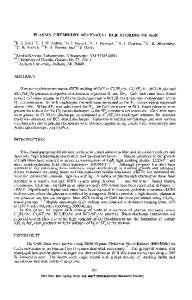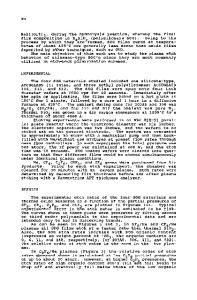Plasma Etching of Tungsten Silicide Structures Using NF 3 -Halocarbon Etchants
- PDF / 1,070,428 Bytes
- 6 Pages / 420.48 x 639 pts Page_size
- 37 Downloads / 237 Views
PLASMA ETCHING
OF TUNGSTEN SILICIDE STRUCTURES USING NF 3 -HALOCARBON ETCHANTS
JOHN G. LANGAN', JEFFREY M. PARKS'-, MARK A. GEORGE-, AND RALPH J. JACCODINE'" *Air Products and Chemicals, Inc., 7201 Hamilton Blvd., Allentown, **Sherman Fairchild Laboratory, Lehigh University, Bethlehemm, PA. 18015
PA.
1.8195
ABSTRACT The feasibility of utilizing NF•-halocarbon mixed etchants to anisotropically etch tungsten silicide structures has been investigated. CVD tungsten silicide was etched with various mixtures of CF 3 Cl and CFAC1, to which 0 to 50 vol percent NF3 was added under a variety of conditions. Anisotropy, undercutting, and notching were evaluated using cross-sectional SEM. Relative etch rates and selectivity for each gas mixture were also Halocarbon residues were investigated using XPS and related to determined. side wall passivity.
INTRODUCTION Recently it has been shown that fast, anisotropic etching of deep trenches in silicon is possible using combinations of NF3 and various Etch rates of greater than 0.50 um/min are possible halocarbon gases'. NF., discharges are or no undercutting of the SiO mask. with little characterized by their efficient generation of atomic fluorine relative to 2 other commonly used etchants (CF,, SF 6 ) . This leads to extremely fast NF3 etching generally silicon etch rates with good selectivity to SiO. CF 3 C1, CFC12 , or CF.,Br can be results in isotropic profiles, however. added to the NF, discharge to control etch profiles and minimize Small area X-Ray Photoelectron Spectroscopy' has been used to undercutting. This characterize the surface of wafers etched in these discharges. analysis showed extensive fluorocarbon residue on the silicon surface at It was proposed that polymer formation high halocarbon concentration. The passivates the sidewalls of the features, inhibiting lateral etching. concentration of halocarbon needed for passivation, and type of polymer It is the goal of the formed depended on the particular halocarbon used. current work to extend this chemistry to the etching of tungsten silicide / polysilicon (polycide) structures. Polycide structures are used in place of highly doped polysilicon for have low resistivity, but gate interconnects. Refractory metal silicides 4 form a poor interface with gate oxides. "s A combined structure of silicide on top of polysilicon provides good resistivity and interface properties. Etching these structures requires a process that will etch the silicide and or no undercutting, and good polysilicon at similar rates with little A number of processes have been used selectivity to the underlying oxide. 4 The majority of these to etch the different metal silicide structures. `processes rely on fluorine and/or chlorine based chemistries to form volatile silicon and metal halogen compounds and use the relative concentrations of the two halogens to control the profile of the etched feature. Tungsten silicide etching in particular has received some 9 CF./O 2 '-, attention (for a fairly recent review see reference 6). 1 3 2 CFCl 2 t , a
Data Loading...







